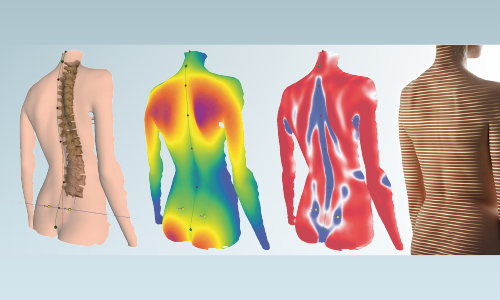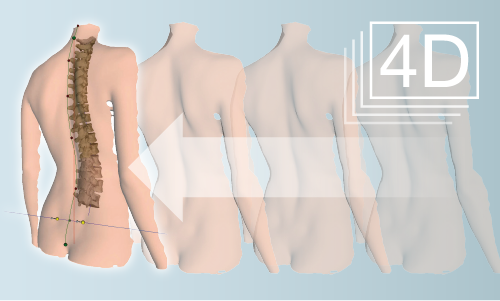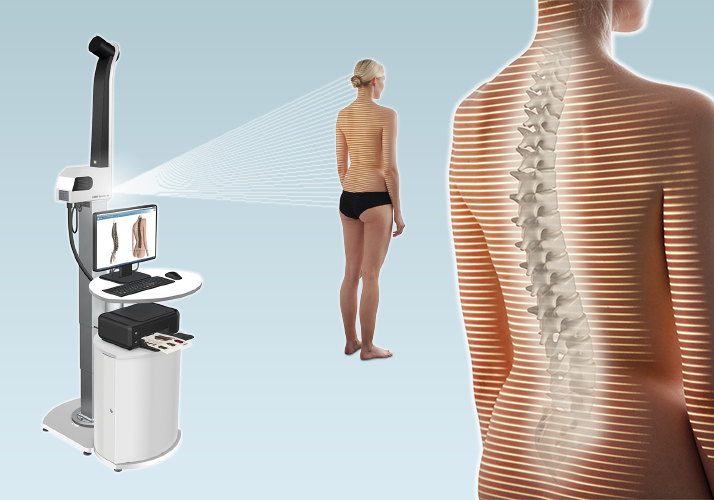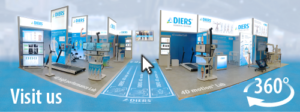Spine & Posture Analysis
DIERS formetric Technology – The first and most widespread system worldwide for light-optical 3D/4D Spine & Posture Analysis
DIERS formetric 4D
The pioneer technology for light-optical 3D/4D Spine & Posture Analysis
The DIERS formetric is a light-optical scanning method based on Video-Raster-Stereography (VRS). Accordingly, the system consists of a light projector which projects a line grid on the back of the patient which is recorded by an imaging unit. A computer software analyzes the line curvature and generates from it – by means of the method of the Photogrammetrie – a three-dimensional model of the surface, comparable to a plaster cast. In opposition to x-ray, the DIERS formetric provides comprehensive information about the whole body statics and posture in only one measuring process, e.g. spine curvature (lateral and frontal), vertebral rotation, and pelvic position. Even muscular dysbalances can be detected based on the curvature image of the back surface.
DIERS 4D posture Lab
The Compact Solution for Comprehensive Posture Analysis
By the combination of the two measuring systems DIERS formetric 4D and DIERS pedoscan it is possible to inspect simultaneously the spinal form, the pelvic position, the pressure conditions under the feet and the body’s center of gravity.
This synchronized measurement is a valuable feature for an optimal treatment e.g. with posture-correcting insoles.
The DIERS 4D motion® system is the leading technology in the field of 3D spine and surface topography. For the first time it is possible to visualize the complex motion pattern of the spine and pelvis during walking and to monitor the results. This technological breakthrough is based on the innovative software and an advanced camera system.
DIERS 4D motion®
Dynamic Spine & Posture Analysis
The DIERS 4D motion® system is the leading technology in the field of 3D spine and surface topography. For the first time it is possible to visualize the complex motion pattern of the spine and pelvis during walking and to monitor the results. This technological breakthrough is based on the innovative software and an advanced camera system.
DIERS 4D motion® Lab
The Compact Solution for Motion Analysis
The 4D motion® system for dynamic spine measurement is the key technology for the developement of the DIERS 4Dmotion®Lab. This motion laboratory allows the synchronized measurement of the whole musculoskeletal system in a small amount of space and with easy preparation.
Highlights

Scientifically based & clinically proven
The DIERS formetric measuring procedures were developed in close collaboration with leading universities and through research projects with the European Union. The original clinical objective was the development of a radiation-free spine analysis system to reduce the high X-ray exposure of scoliosis patients during follow-ups.

The radiation free alternative to x-ray
The DIERS formetric is a light-optical scanning method based on Video-Raster-Stereography (VRS). Accordingly, the system consists of a light projector which projects a line grid on the back of the patient which is recorded by an imaging unit. A computer software analyzes the line curvature and generates from it – by means of the method of the Photogrammetrie – a three-dimensional model of the surface, comparable to a plaster cast. In opposition to x-ray, the DIERS formetric provides comprehensive information about the whole body statics and posture in only one measuring process, e.g. spine curvature (lateral and frontal), vertebral rotation, and pelvic position. Even muscular dysbalances can be detected based on the curvature image of the back surface.

3D Surface & Spine Reconstruction
Unlike any other systems, the DIERS formetric also delivers a 3D reconstruction of the spine without using reflecting marker dots. By the Automatic Detection of Anatomical Landmarks and a scientifically based Correlation Model (by Turner-Smith & Drerup), which describes the relation between the surface curvature and the orientation of the vertebra, it is possible to reconstruct the curve of the spine and the pelvic position.

Automatic Detection of Anatomical Landmarks
There is generally no need for reflecting markers, because the anatomical fixpoints Vertebra Prominens (VP), Sacrum Point (SP), Dimple Left (DL) Dimple Right (DR) as well as the spinal center line and spinal rotation are automatically detected by the system. That allows a very time-saving and reliable examination procedure.

4D Average Technology
The innovative 4D technology (3D + time) ensures a high measurement precision and reproducibility. By means of serial image recording and averaging it’s possible to compensate postural variances due to unavoidable body sway of the patient during the measurement procedure. Furthermore even posture tests and functional studies can be taken over a period of time (e.g. Matthiass-Test, Flamingo-Test, Romberg-Test).







